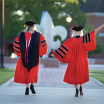Louisiana Accelerator Center: Research for a Reason
The UL Lafayette Louisiana Accelerator Center brings together faculty members, researchers, graduate students and industry professionals to “tackle problems which are relevant to society,” says center director Dr. Harry J. Whitlow.
And that research affects everything from our teeth to our waterways to space exploration.
“We get to work with a lot of very-top scientists, and that’s stimulating because we can help them in their work,” he says, “and that helps us because it means we have interesting topics to work on — and that these topics are relevant.
“That’s what I get a kick out of: doing things that are relevant. I care about the impact.”
Relevant research — with myriad applications.
Electronics in space
One of the most impressive instruments at the Louisiana Accelerator Center is the ultra-low fluence irradiation beamline end station, which was built by Jay Dias, ‘18, in the Master of Science in physics program. It’s used to simulate proton irradiation in space, which is the dominant form of radiation coming from the sun and other far-off cosmic sources.
Massive proton ejections accompany solar flares, causing radiation levels to spike significantly. By recreating the radiation and simulating the effects of radiation on satellite components, electronics, and lenses, they can determine if the components would degrade or change as a result. With these same methods, they can also simulate the effects of radiation levels on cells, helping to determine how organisms and even humans would be affected.
Airbag sensors
Dr. Whitlow’s area of expertise is ion-matter reactions and their applications. At the LAC, he uses ions to transfer energy to different materials, which change them. In that vein, he is working with graduate student Kyle Coutee in the physics master’s program on the potential for a novel type of material electrets applications in sensors. More specifically, these can be used in airbag sensors for cars — the sensor measures the sudden change of speed in the car and then signals that the airbags should inflate.
Administering insulin
The team at the Louisiana Accelerator Center is also exploring how electrets made with ion beams can be used for energy harvesting that could be used to help diabetes patients. An implant or wearable device can convert body movement into electrical energy, which can then measure blood sugar levels and administer a tailored dose of insulin, which gives the patient much more control and stability than conventional methods.
Cavity fillings & wheel bearings
At the recent International Conference on Ion Beam Analysis, a team led by Dr. Wanwisa Sudprasert from Thailand’s Kasetsart University that also included Dr. Whitlow and UL Lafayette physics master’s student Henry Odeogu, won an award for the best science work for their research on mercury pathways in dental amalgam, which is used to fill cavities. Through their work, this international team of researchers disproved their initial hypothesis when analyzing the distribution of mercury where the amalgam and enamel meet and at the biting surface.
“It’s quite interesting because it was a process that is also problematic for the watchmaking industry, of all things,” Dr. Whitlow explains. “Also in the 1940s and ‘50s, the Ford automotive company was transporting cars by rail … and the bearings on the cars were rubbing on just one place as they were transported. It led to the premature failure of the wheel bearings, so it’s a problem on a large scale, but it was also actually happening on the biting surface of the amalgam.”
Lead and other toxin levels in water
Apple snails, a non-indigenous invasive species in Louisiana, hold the potential to be environmental sensors in Louisiana waterways. The snails’ shells absorb toxins and other materials from their environment, including lead. As researchers at the Louisiana Accelerator Center and the Ecology Center analyze the uptake of lead in these apple snails’ shells, they’re exploring the possibility of using them to measure the quality of the water where they reside.
Upcoming research for a reason
The Louisiana Accelerator Center recently received a grant to build a new instrument for organic molecule imaging, which will be used to image specific biological molecules. When working with University biologists, they will be able to look at signal substances in neurological cells, which affect behavior.
Dr. Whitlow is constantly looking for more collaborators and is working with biologists, geologists, physicists and radiation scientists at the Louisiana Accelerator Center. And he’s especially committed to including graduate students as collaborators.
“I get a sense of creativity from working with grad students,” he says. He prioritizes the “hands-on task” of preparing grad students to do research — “how to set up questions, to set up tests to test their hypothesis, and then how to interpret the results and most importantly how to present it.”
“Our philosophy is that we’re here to promote the research within the University and also the surrounding companies and environment,” says Dr. Whitlow.
“This is why it’s important to meet with the other scientists and find out what they’re interested in — because sometimes they could have a solution to our problems and we could have a solution to their problems. By this manner, we can drive science forward. We are very much in a cross-disciplinary science, and that’s where the great discoveries are made.”
Learn more about the Louisiana Accelerator Center.
Interested in earning your master’s in physics? Learn more about graduate studies in physics at UL Lafayette.
